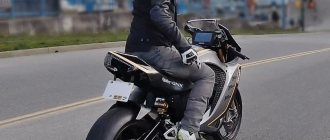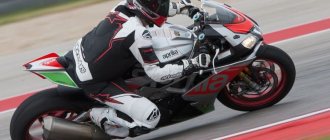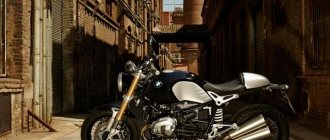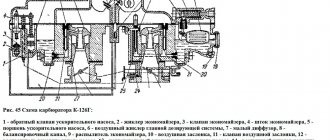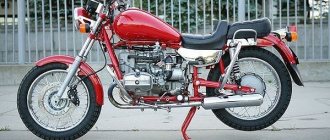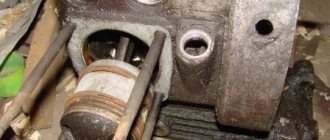For many Russian motorcyclists, the first bike is the Ural M 67 36 - Soviet industry produced hundreds of thousands of copies in the 70-80s of the last century, and many of them are still alive. Affordable price, reputation as a “tough motorcycle for real men” and phenomenal maintainability made this bike incredibly popular.
Specifications
In the Urals, the technical characteristics depend on the specific model, of which there were many. Being, according to the official classification, a heavy motorcycle, this model was equipped with a side trailer and had a solid length of the frame and chassis as a whole.
Engine
On early models, the engine capacity of the Ural motorcycle reached 750 cubic meters. cm, but on the M67 it was reduced to 650cc . Power is 36 horsepower on later versions and 32 on early versions . boxer motor weighs a lot, and dismantling it requires considerable force, so this operation is definitely not possible to cope with alone.
Transmission
All Urals were equipped with a 4-speed gearbox with reverse gear , which was activated by a separate lever. The mediocre reliability of the gearbox led to the fact that many owners replaced it with one from the Dnepr, which was distinguished by a less reliable engine, prone to cranking of the liners, but at the same time a less problematic transmission.
Chassis and brakes
The recipe for the Soviet monster is simple - more iron! A steel frame , spoked tube wheels, toothy tires for dirt roads, a primitive but extremely reliable suspension - this is a completely comprehensive characteristic of the Ural chassis. The brakes were mechanical, drum , so their efficiency cannot be called high. There is no fuss with spring-oil shock absorbers either; even without maintenance, they can feel great for years.
Electronics
There are a minimum of wires in the Urals; 12-volt battery is used . It is worth immediately replacing the armored wires and spark plug caps with better ones, since the caps, exposed to bad weather, heat up from the cylinders, and after driving through a puddle they cool down sharply and therefore often crack. Rubber models instead of plastic ones have proven themselves well.
Weight and dimensions
The weight of the Ural motorcycle without a sidecar is about 220 kg , and a hundred kilograms more with it. By modern standards, its mass cannot be called large; many cruisers weigh one and a half times more. And it’s worth remembering that, due to the presence of a side trailer, the Ural is comparable in width to a small car, so you can’t fit it between the rows.
Controllability
The Ural M 67 with a side trailer is extremely difficult , and it is not recommended . When turning, you need to slow down, as a three-wheeled motorcycle has a tendency to tip over. And without a side trailer, it can reach speeds of up to 110 km/h , and in this case it is much easier to control.
Fuel consumption
The refueling volumes on all modifications of the Urals are almost the same, the M67 was no exception. The tank capacity is 19 liters , which provides about 200 km of travel without refueling . The engine was originally designed for AI-76, so you can safely fill it with the cheapest gasoline.
How to check the foot switch mechanism
The need to adjust the foot shift mechanism may be necessary after the transmission has been rebuilt or if the locknuts have become loose. To do this, move the motorcycle manually and change gears from 2nd to 3rd and vice versa. It is necessary to achieve easy switching. The motorcycle is also placed on a stand, the rear wheel is hung out and the engine is started. When switching from third to second speed, you need to press on the front shoulder of the pedal. Looking to the left, the pedal should turn counterclockwise and the pawl crank clockwise and will therefore rest against the top stop. It needs to be adjusted.
Repair and tuning
Close to 100% maintainability and huge scope for tuning are the strengths of the Urals . But all this will require a garage, a lot of tools and even more free time.
Repair
The Ural motorcycle requires attention often, and breakdowns happen from time to time. To avoid them, the bike needs to be given the closest attention, often servicing the cardan, adjusting valve clearances, setting the ignition correctly and performing other service operations.
Spare parts
They are available and inexpensive, but the quality varies from acceptable to extremely poor. The mediocre quality of spare parts is one of the reasons for frequently occurring problems.
Tuning
It is the old Urals that most often act as donors for novice customizers due to their low cost. They make a lot of things out of them, from trikes and custom choppers to scramblers and even sportbikes . The results sometimes smack of rural charm, but there are also some very worthy customs.
Motorcycle modifications
The original M67 was produced until 1984, and only in the configuration with a side trailer, but without third wheel drive. It was replaced by modification 8.103.30, which has much in common with it. And since the 90s, the production of completely different Urals began - “Solo”, “Voyage”, “Wolf” and others. Currently, the Ural plant in Irbit produces completely different models that have little in common with the old Urals.
Transmission
On the M 61 and M 62 a clutch is installed, similar in design to the K 750 clutch, but the K 750 clutch is adjusted by one adjusting screw screwed into the clutch release lever, and the M 61 and M 62 clutches by two screws: an adjusting screw in the release lever and a shell stop screw cable screwed into the crankcase bracket.
Cardan and final drive diagram.
The power transmission gearbox of the Ural M 61 and M 62 motorcycles is the same in design as the M 72. True, there is not much difference, the M 62 differs from the M 61 only in the design of the shift couplings, the secondary shaft and its gears.
The cardan transmission is identical in design to the K750. The rear gears of the M 61, M 62 and K 750 are the same, with the exception of the crankcase covers: for the M 61 and M 62 motorcycles, the crankcase cover is made integral with the right suspension bracket, and the cover has an oil filler hole.
Advantages and disadvantages
The strengths and weaknesses of the model are obvious, and they are inextricably interrelated. The archaic and outdated design half a century ago is unreliable, but thanks to its simplicity bordering on primitivism, it is easy to maintain and repair.
Advantages
- Quite high power compared to most other Soviet motorcycles.
- Huge scope for tuning . What craftsmen don’t install on Urals, from the injector to the fifth gear!
- Total maintainability . The bike can be repaired no matter what happens to it. Always.
- Undemanding to the quality of gasoline.
- Short service intervals . Valves require frequent adjustment.
Flaws
- The deplorable technical condition of most copies.
- Low quality components , which leads to frequent minor breakdowns.
- High fuel consumption .
How does a gearbox work?
On the secondary shaft, the gears have splined rims, with which the gear clutches alternately engage, moving along the outer splines of the secondary shaft couplings. Gear shifting occurs using splined couplings, the movement of which is ensured by the gear shift fork. The forks are not interchangeable and are driven by a sector welded to the shaft. There are two grooves in the sector where the fork spikes fit. Using the manual gear shift lever, the sector is set to one of five possible positions.
Owner reviews
A powerful unit with decent performance characteristics, in the right hands can live forever, or as long as there are spare parts. Considering how many opposition pieces were riveted in the USSR, there is every chance of passing it on to one’s grandchildren as an inheritance. Anyone who says that this is a bad spender simply does not know how to handle it. Igor, Smolensk.
I started my two-wheeled life with a stroller, like many, and rode until I earned money for an old Honda Steed. When I sold the stroller and switched to a Japanese one, I drove it once and realized that when I go to hell, part of the torment will be credited to me there))) Ivan, Tver.
In stock condition, it’s trash, killed by a disregard for it. With the right approach, the motorcycle is reliable and durable, it will go anywhere, there are enough horses and torque, it can be repaired with a hammer and a screwdriver, and it will eat any gasoline. If you put survivability at the forefront, then Uralei has no competitors except old Harleys, but here the price of the issue is completely different. Anton, Murom.
Fault Inspection
When inspecting the parts, you should check the ease of movement of the forks along the rod. Condition of fork stays and ring grooves in movable couplings. The amount of axial movement of the forks in the groove of the engagement couplings.
The following malfunctions may occur in the trigger mechanism: - wear, crushing or chipping of the pawl; — jamming of the pawl pusher; — breakage of the pawl spring; — bending the ends of the return spring of the starting pedal; — damage to the working end of the buffer pin; — cracks in the starting lever; - wear of the oil seal.
Source
FAQ
- How much does a Ural motorcycle weigh without a sidecar? Not much - about 220 kg. But many owners dismantle the cradle permanently, removing some components and thereby making the bike lighter.
- How many cubes are there in a Ural motorcycle? In older models - 650. In modern ones - 750.
- How much does a Ural motorcycle with sidecar weigh? Weight varies depending on the specific modification, but on average it is about 320 kg.
- Is it comfortable to drive around the city? Not very much, given the solid overall dimensions.
- How much does he really eat? A bike without a sidecar consumes about 6 liters when riding leisurely on the road. But if you drive aggressively, the consumption will be higher, up to 8 liters or more.
masses of units
Moderator: User buggy
masses of units
Post by Nitro » Mon Apr 21, 2008 7:05 pm
There is no data on radiators. Accordingly, most of the data is not available, but you can estimate
Power unit 2101 117 kg Lubrication system 2101 3.75 l Cooling system 2101 9.9 l
Power unit 2108 82 kg Lubrication system 2108 3.5 l Cooling system 2108 7.8 l
Power unit 331.7 128 kg Lubrication system 331.7 4.8 l Radiator 2141 5.5 kg Cooling system 2141 9 l
Power unit 1111 66.5 kg Lubrication system 1111 2.5 l Cooling system 1111 4.8 l
KP 2101 26 kg Carter KP 2101 1.35 l
KP 2108 34 kg Carter KP 2108 3.3 l
KP 2141 40 kg Carter KP 2141 3.4 l
KP 1111 24.5 kg Carter KP 1111 1.8 l
Rear hub 2108 assembled 2.5 kg Brake disc 2108 4 kg Knuckle 2108 4.5 kg Caliper 2108 3 kg
CV joint 2141 standard 6 kg
Seat UNP Racer 12 kg
Gas tank 2101 39.0 l = 28.7 kg Gas tank 2104 45.0 l = 33.1 kg Gas tank 2108 43.0 l = 31.6 kg
Wheel 2108 beskam 13.4 kg Wheel 2410 21 kg
Post by zilbergilzen » Mon Apr 21, 2008 9:57 pm
Post by wat » Tue Apr 22, 2008 1:43 am
Posted by Nitro » Tue Apr 22, 2008 9:12 am
Post by zilbergilzen » Tue Apr 22, 2008 6:40 pm
Post by ForSash » Tue Nov 18, 2008 10:14 am
We don’t yet keep it in the public domain in the form of a complete reference book, but you can look at the characteristics of individual parts. In particular, here on the website https://www.avtoall.ru, in our product cards, the weight is marked for the spare part, if it is known to us. (don't take it as an advertisement)
Post by ilmar » Tue Nov 18, 2008 1:27 pm
Posted by ACD » Tue Nov 18, 2008 1:54 pm
Post by ilmar » Tue Nov 18, 2008 2:36 pm
Post by ForSash » Tue Nov 18, 2008 3:28 pm
Source
Conclusion
Many bikers started out as boxer road veterans found in grandpa's garage. Ural M 67 is an excellent learning desk that will teach you not only how to ride, but also how to maintain a motorcycle, and of course, how to repair it. And after this fiend of the Soviet motorcycle industry, you will be able to handle any other bike! This is the case when starting with a structurally simple motorcycle would be a good idea, especially since a fair number of them can always be found on the secondary market, and for very modest money.
Specifications
| Maximum engine power: | 36 HP |
| Working volume: | 649 cm3 |
| Motor type (cylinder arrangement, number of strokes): | Opposed |
| Number of cylinders: | 2 |
| Number of valves: | |
| Intake type (Injector / Carburetor): | |
| Bore and stroke: | |
| Starting system (Electric starter, kick starter): | |
| Maximum speed in km/h: | 105 km/h |
| Cooling system: | Air cooling |
| Transmission (gearbox): | 4-speed, manual |
| Clutch (Dry / Wet): | |
| Drive unit: | Cardan |
| Frame: | Steel tubular |
| Chassis | |
| Suspension (front/rear travel): | |
| Brakes (Front/Rear): | |
| Wheels / Tires / Rubber: | |
| Dimensions and weight | |
| Dimensions (Length / Width): | |
| Seat height: | |
| Ground clearance: | |
| Curb weight: | |
| Weight: | 330 with stroller kg |
| Fuel tank capacity: | 19 l. |
| Battery capacity: | |
| Year of release: | |
| Country of Origin: |
Chassis
The M62 is equipped with a telescopic fork with hydraulic shock absorbers and internal springs. The difference between this fork and the M72 fork is a different spring arrangement and a slightly different design of the fork leg shock absorber.
Each shock absorber consists of a housing, a rod 11 with a piston 17, a lower guide and a housing nut. The shock absorber body is placed inside the fork leg tube. Holes for oil passage are drilled in the lower part of the housing.
The piston has a disc-shaped shape. The edges of the piston fit tightly to the inner surface of the shock absorber body.
The shock absorber tube nut is a cup with a calibrated hole in the center. A rubber buffer is installed inside the nut to protect the piston from sudden impacts.
The shock absorber body moves along with the tips of the fork stays, and the rod and the lower guide rod with the piston are stationary
.
A fork spring is screwed onto the spiral groove of the shock absorber body nut, the upper end of which is screwed onto the spring tip mounted on the rod and clamped between two nuts.
When assembling the front fork, you must ensure that there is a gap of 0.2-0.5 mm between the upper tip of the spring and the nut locking the tightening nut of the fork leg tube, ensuring free rotation of the tightening nut with the rod.
M 62 front fork diagram
The rear suspension of the chassis consists of two identical units, does not have hydraulic shock absorbers and is installed in the rear frame brackets.
The right bracket is made in one piece with the rear gear housing cover, while the left one is a separate part. Both brackets have the ability to move on steel rods.
The suspension springs are screwed onto the suspension brackets and onto the spring tip and covered with protective covers. The lower parts of the springs are connected to the wheel axle, and the upper parts are connected to the motorcycle frame.
Rear wheel suspension diagram.
Wheels
The M 62 is equipped with wheels with steel or aluminum hubs.
Both types of wheels are interchangeable. To ensure interchangeability of motorcycle and sidecar wheels, an adapter sleeve with an outer diameter of 25 mm is installed in the hub.
The wheel with a steel hub has 40 spokes: 20 long with curved heads and 20 short straight. In a wheel with an aluminum hub, all spokes are the same length with curved heads.
The stroller has a torsion bar suspension.
Return to contents — ↑

